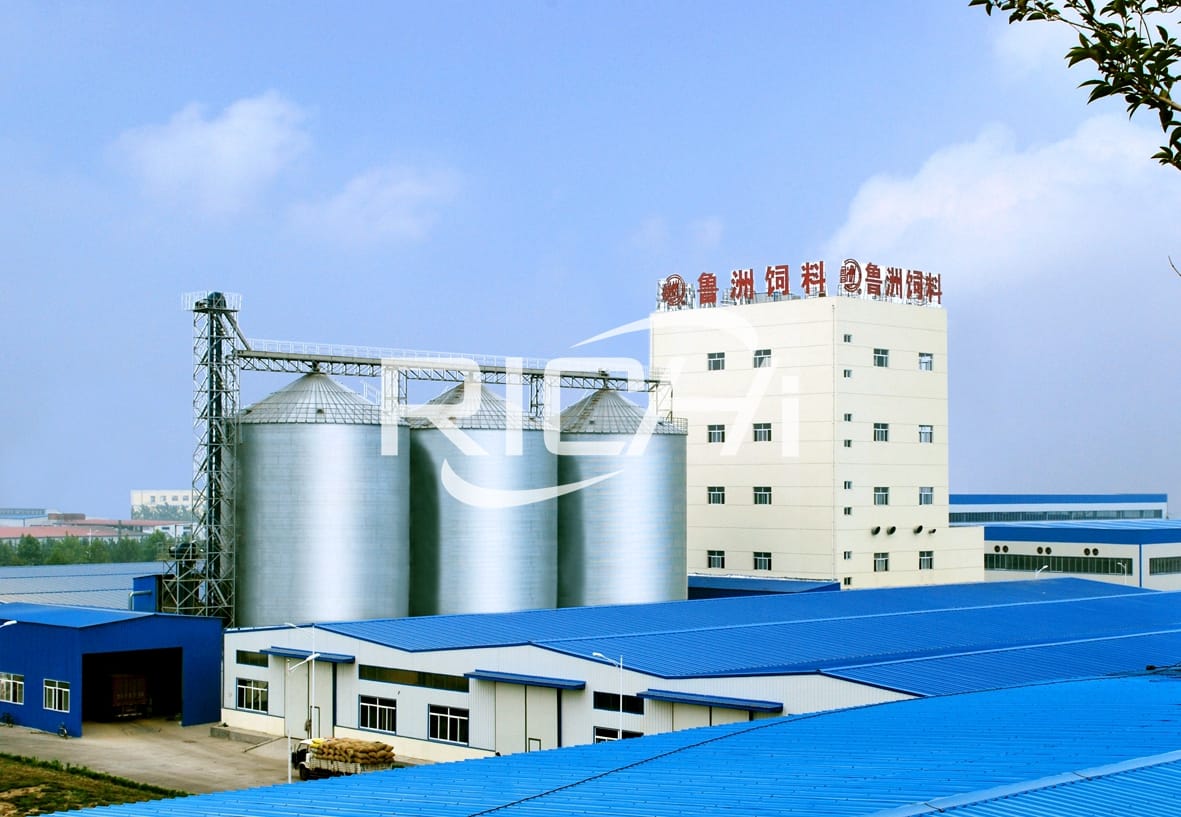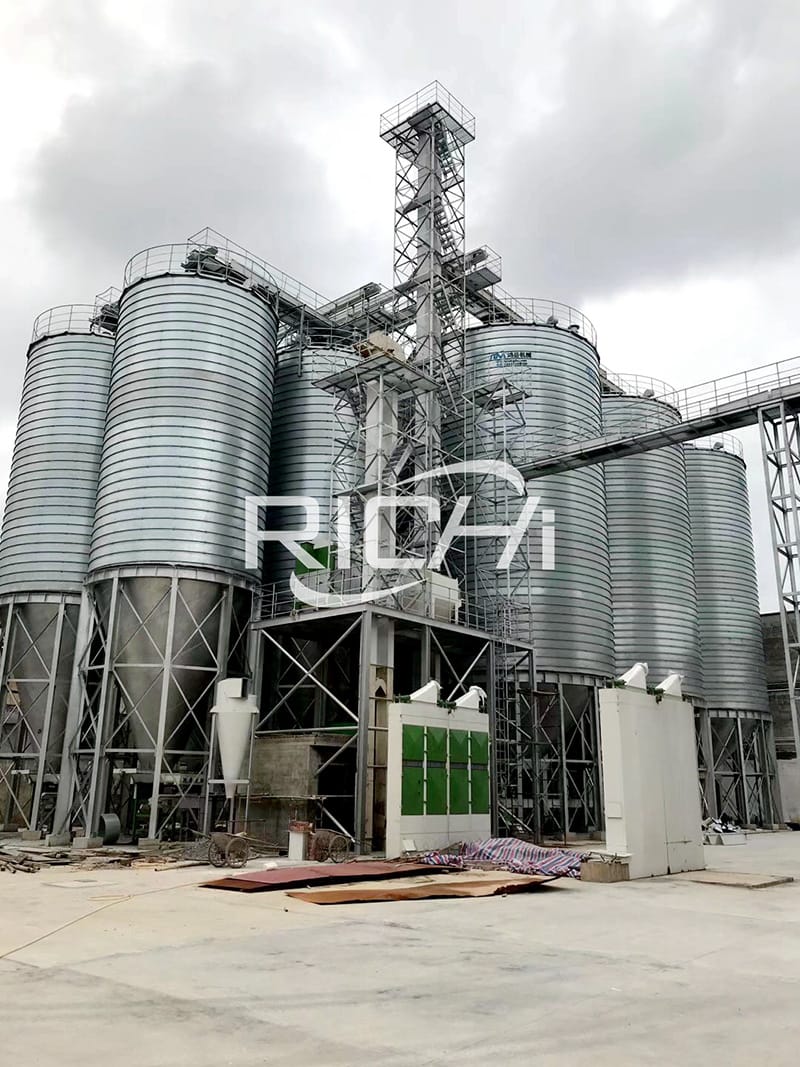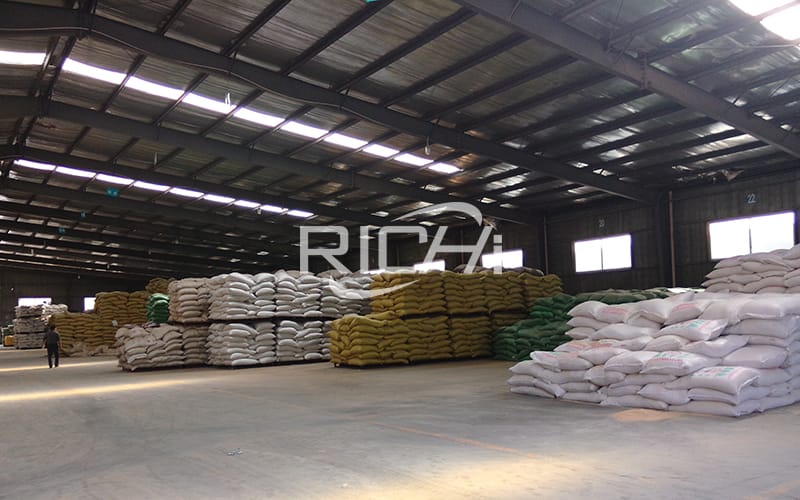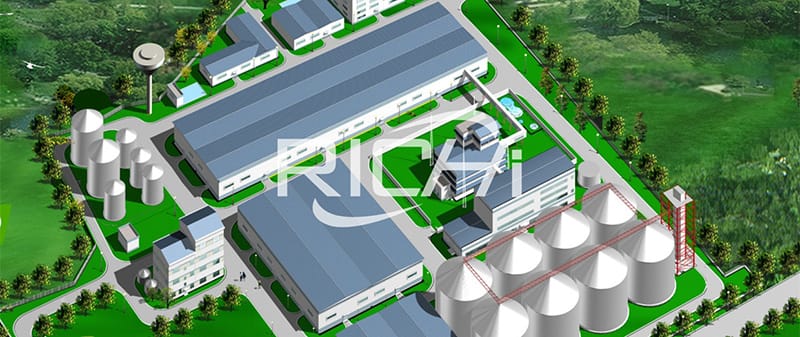How to build the internal functional area of a new animal feed mill plant?
Today's content mainly talks about "the internal functional area planning of a new animal feed pellet processing plant". Of course, today's content is for medium and large feed mills. Because the feed industry is very promising, many people want to do something in this industry, so they want to invest. But many people do not know how to plan a new animal feed mill factory. Today, Richi Machinery is here to share with you the "internal functional area planning of a new feed making plant factory", I hope it will help you.

1. Selection of the way of receiving and storing raw materials in the animal feed producing factory
Feed ingredients can be divided into pellets and powders in form, bulk and bagged in packaging, and transportation by cars, ships and trains. Different forms, packaging and transportation of raw materials, the receiving and storage methods will be different, but suitable and advanced technology and equipment should be adopted to ensure the receiving speed and ability to meet the production needs, and reduce the labor intensity of workers,reduce the cost of production. For granular materials such as corn and wheat, large-scale livestock feed mill and poultry feed plants should be equipped with a vertical silo raw material receiving system to achieve a high degree of mechanization of receiving, storing, and discharging pellets, eliminating the need for labor.
For powdered raw materials such as meal, DDGS, etc., due to poor fluidity, easy arching, compaction, and difficulty in unloading, most animal feed mills still use bags and rely on manual handling and feeding. However, with the expansion of the production scale of animal feed mill processing plants, the storage and feeding of such raw materials continue to use manual methods. Not only the labor intensity of the workers is high, but also the production efficiency is seriously affected, and the further expansion of the production scale is restricted. The use of silo storage is an inevitable trend .
Soybean meal, etc. are stored in silos, which can realize bulk receipt of materials and automatic release. There is no labor factor, which reduces water loss and cross-contamination. However, the problem of material discharge must be considered to prevent poor flow, formation of compaction, arching, and inability to flow. Therefore, for small silo with a small storage capacity (200~300 t), the silo discharge port can be designed as a rectangle, and according to the size of the silo, it can be equipped with single, double or triple screw discharge; for large silo with a storage capacity of more than 1 000 t , Must be equipped with an active out-of-warehouse system to ensure the overall flow of materials, first-in first-out, and complete discharge.
Other raw materials that are not suitable for storage (such as bran, rice bran, fish meal, etc.) should be bagged and unloaded on pallets. Forklift handling and manual feeding can improve the efficiency of raw material supply in the production process, reduce human participation, and facilitate Energy saving.

2. Determination of the silo capacity and room storage area of the animal feed mill
To build a new customized feed mill plant, reasonably determine the capacity of the vertical silo, the area of the room-type raw material warehouse and the finished product warehouse, and control the reasonable inventory level are of great significance for ensuring the continuity and stability of production, reducing feed costs, and improving the economic benefits of the enterprise. It can prevent the increase in investment costs due to the excessively large scale of storage capacity construction.
However, there is no consensus on how to determine a reasonable warehouse capacity. The storage capacity is too small, which affects production efficiency and continuity of production, may cause frequent purchases of raw materials, and increase purchase and inspection costs. The warehouse capacity is too large, in addition to the increase in investment costs, it will inevitably increase the storage costs such as the interest of the funds occupied by the raw materials and finished products, and the loss during the storage period.
The inventory of each raw material is related to the design daily output of the complete animal feed mill factory, the proportion of the raw material in the formula, and the storage days of the raw material. For a feed factory, after its product plan, product formula, and production scale are determined, the daily demand for each raw material can be estimated, and then the amount of stock that should be allocated is calculated according to the storage days of each raw material. It is generally believed that 7~10 days of storage days for main raw materials with sufficient supply of raw materials and convenient transportation, such as corn, are the best.
When the animal feed pelletizing line plant is far away from the main raw material supply area and requires a longer transportation time, the storage period can be 20~ Considering 30 days, for raw materials with strong seasonality, the storage period can be as long as 3 months. According to the storage volume, storage period, unit area or volume storage capacity of each raw material, the required silo capacity or actual storage area of the raw material can be calculated. Generally, the floor area utilization rate of the room-type raw material warehouse is 50%~ 60%. In this way, the warehouse area required for each raw material can be calculated and added together to get the total area of the raw material warehouse.
The inventory of the finished product warehouse is related to the designed daily output of the animal feed pelltizing plant and the inventory period of different feed products. The general inventory is 3-7d. The actual storage area required for the finished product can also be calculated according to the storage volume, storage period, and storage volume per unit area of the finished product. Generally, the floor area utilization rate of the finished product warehouse is 55%-65%, so that the finished product warehouse can be calculated. The warehouse area.
With the expansion of large-scale aquaculture and the adoption of mechanized feeding methods in farms, more and more packaging processes in feed factories will be replaced by economical bulk processes. The finished feed products will be directly transported to the feedlot via bulk trucks to reduce packaging costs. . The number of bulk finished goods warehouses should be more than 6 to meet the needs of changes in market demand and a significant increase in varieties. The total capacity of the bulk finished product warehouse should have at least 2 shifts of production capacity to ensure continuous production.

3. Regional planning of raw materials and finished product warehouses in animal feed pelletizing plant
For a new animal feed mill plant, whether it is a wide variety of raw materials or product varieties, the warehouse area planning of the house-type raw material warehouse and the finished product warehouse can make different kinds of products go to their respective positions. The warehouse management is clear and standardized, and the mixing is reduced or eliminated, which is convenient Realize "first in, first out" management; optimizing the location of different varieties can shorten the distance of movement in and out of the warehouse, shorten the operation time, reduce the cost of transportation, and reduce the loss in the storage and transportation process, thereby reducing waste and saving Cost, improve work efficiency.
The regional planning of the warehouse should be divided into blocks according to the different types of storage, and the raw materials or finished products of different varieties and batches should be placed in piles and zones. Whether the planning and layout of each zone is reasonable will affect the efficiency, quality and quality of warehouse operations. Cost has a great impact, and regional planning should follow the following principles:
① According to the amount and frequency of use of raw materials, the output of finished products and the frequency of outgoing, rationally plan the location and area of each raw material or finished product. The frequent incoming and outgoing products should be placed in In the fixed area closest to the raw material feeding port or the finished product delivery outlet, the storage location should be adjusted in time according to the changes in the raw material, product usage or production volume, so that the storage space can be used effectively.
②The storage is divided according to the material category. The same type of material should be stored in the same area as much as possible to facilitate management, easy to identify and inspect, check the storage quantity, etc.; it should be stored in batches in piles to facilitate strict implementation of the first-in first-out principle.
③ Different types of materials have different packaging forms and quality requirements. The stacking method and number of layers should be set according to the packaging form and quality requirements of the materials; for different types of materials with similar packaging appearances, they should be stacked away from each other to prevent mixing and difficult to distinguish.
④ Planning the transportation channel with the handling equipment in the warehouse, which should have an appropriate width and maintain loading and unloading space, so that the material handling can proceed smoothly.
⑤ Mark all kinds of materials on the floor plan of the warehouse according to product names, specifications, batch numbers, etc., and display inventory trends at any time.

4. The choice of logistics transportation in the 1-100tph animal feed pellet proceessing plant
The logistics and transportation methods and transportation efficiency of feed production enterprises are closely connected with the receiving and storing methods of raw materials and the delivery methods of finished products. The raw materials stored in the silo can be directly sent from the silo to the warehouse to be crushed or the batching warehouse through the conveyor equipment such as scraper conveyors and bucket elevators when the materials need to be fed in the production process. Realize the mechanization of feeding. If all the raw materials that can be put into the silo are stored in the silo, the manual handling and feeding amount can be greatly reduced, the feeding efficiency is improved, and the raw material warehouse area and labor costs can be reduced. The feed products are packed in bulk, without manual packing and handling, and directly flow from the bulk finished product warehouse into the bulk transport truck, which will greatly improve the delivery efficiency and reduce the finished product warehouse area and labor costs.
However, at present, most animal feed manufacturing plants only use granular raw materials into the silos, and the finished products are still packed in bags. Manual loading, unloading and transportation are widespread. What kind of intra-plant logistics transportation method is adopted to minimize the cost and time during the transportation process, while reducing It is very important for labor intensity to improve staff efficiency. The handling of materials in the feed factory mainly includes unloading, warehousing, palletizing, out-of-warehousing and feeding of raw materials, warehousing, palletizing, out-of-warehousing and loading of finished products, handling and feeding of small materials, head and tail materials, unqualified products , Handling and stacking of cleaning materials, etc. The material handling methods in the factory mainly use forklifts, forklifts, motorized flat cars, trolleys and other transportation vehicles and mobile belt conveyors, which are flexible and easy to use.
(1) Transportation of raw materials in the animal feed processing plant
For bulk materials, if they cannot be directly fed into the silo, they can be stacked and transported to the feeding port with a forklift for direct feeding; or they can be manually bagged before being transported and stacked. For bagged raw materials, there are currently four main handling methods:
① All manual operations are used. When raw materials are received, manual unloading and manual palletizing are carried out using motorized transport flat cars or trolleys; when the materials are out of the warehouse, manual loading, motorized transport flat cars or trolleys are used for handling, and manual unloading and feeding are performed. This method of movers has high labor intensity and low efficiency, and is rarely used in large scale animal feed mills.
②Combined manual operation with belt conveyor. On the basis of manual operations, in unloading, palletizing, loading and other operations, belt conveyors are used for transportation as needed, which can reduce the labor intensity of workers to a certain extent.
③Manual + pallet + forklift operation. When raw materials are received, they are manually unloaded, and the raw materials are directly placed on a pallet of a certain specification, and the stacking form and number of packages of the bagged raw materials on the pallet are specified. Once a pallet is stacked, the pallet raw materials are directly transported to the raw material warehouse with a forklift. The specified stacking area and the number of pallet stacking layers must meet the stacking management requirements of the raw material warehouse.
When feeding materials out of the warehouse, directly use a forklift to fork a pallet of raw materials to the feeding port for manual feeding. This method uses pallet transportation, which is convenient for mechanized operations, accelerates cargo handling, reduces transportation costs, and improves the efficiency of warehousing. At the same time, manual operations are only performed during unloading and feeding. Operations such as warehousing and palletizing do not require manpower, which greatly reduces Increase the labor intensity of workers.
④Manual + pallet + forklift + belt conveyor operation. On the basis of manual + forklift operations, during unloading operations, belt conveyors are used for transportation as needed, which can further reduce the labor intensity of workers.
(2) Transportation of finished products in the complete animal feed production line
The handling of bagged finished products is basically the same as the handling of raw materials, except that the finished product should be considered for loading when shipped, while the raw material should be considered for unloading when arriving.
① All use manual operations and combined manual operations with belt conveyors. These two operations have low efficiency and high labor intensity. Large feed companies have rarely used them, so I will not emphasize them here.
②Manual + pallet + forklift (+belt conveyor) operation. Put the packaged finished product on the pallet manually, and use a forklift to directly transport the finished pallet to the specified stacking area of the finished product warehouse. The number of pallet stacking layers must meet the stacking management requirements of the finished product warehouse. When out of the warehouse for delivery, a forklift is used to directly fork a pallet of finished products to the belt conveyor for manual transportation and loading. For specially customized pallets, a finished pallet can be directly fork-lifted to a transport truck, and then the forklift can only lift the finished product to extract the pallet, which eliminates the need for workers to carry it, and further reduces labor intensity.
③Automatic stacker + pallet + forklift (+belt conveyor) operation. An automatic stacker is used to automatically stack the packaged finished products on the pallets, and the forklift trucks are used to transport them into the warehouse, palletizing, and out of the warehouse, without manual handling. This is currently the most advanced way of handling finished products in China, reducing a lot of manual labor. Reduce labor intensity, good mobility and high efficiency.
5.Customize your customizable easy to use animal feed mill plant:
(3)Pig feed pellet making plant
(4)Chicken poultry feed mill for pellet
(6)Shrimp feed processing plant
(7)Sheep pellet feed manufacturing plant
(8)Camel feed processing plant
(10)Horse feed pellet production plant
......
If you want to built one complete pellet production line in your country, pls send the inquiry to us. We will customized design according to your requirement.



